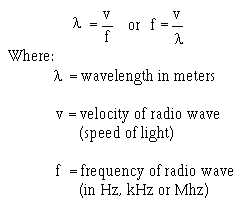2-8
communications. The relationship between frequency, wavelength, and antennas will be discussed in
chapter 4 of this module.
The velocity (or speed) of a radio wave radiated into free space by a transmitting antenna is equal to
the speed of light—186,000 miles per second or 300,000,000 meters per second. Because of various
factors, such as barometric pressure, humidity, molecular content, etc., radio waves travel inside the
Earth's atmosphere at a speed slightly less than the speed of light. Normally, in discussions of the velocity
of radio waves, the velocity referred to is the speed at which radio waves travel in free space.
The frequency of a radio wave has nothing to do with its velocity. A 5-megahertz wave travels
through space at the same velocity as a 10-megahertz wave. However, the velocity of radio waves is an
important factor in making wavelength-to-frequency conversions, the subject of our next discussion.
Q4. What is the term used to describe the basic frequency of a radio wave?
Q5. What is the term used to describe a whole number multiple of the basic frequency of a radio
wave?
WAVELENGTH-TO-FREQUENCY CONVERSIONS
Radio waves are often referred to by their wavelength in meters rather than by frequency. For
example, most people have heard commercial radio stations make announcements similar to the
following: "Station WXYZ operating on 240 meters..." To tune receiving equipment that is calibrated by
frequency to such a station, you must first convert the designated wavelength to its equivalent frequency.
As discussed earlier, a radio wave travels 300,000,000 meters a second (speed of light); therefore, a
radio wave of 1 hertz would have traveled a distance (or wavelength) of 300,000,000 meters. Obviously
then, if the frequency of the wave is increased to 2 hertz, the wavelength will be cut in half to
150,000,000 meters. This illustrates the principle that the HIGHER THE FREQUENCY, the SHORTER
THE WAVELENGTH.
Wavelength-to-frequency conversions of radio waves are really quite simple because wavelength and
frequency are reciprocals: Either one divided into the velocity of a radio wave yields the other.
Remember, the formula for wavelength is:
The wavelength in meters divided into 300,000,000 yields the frequency of a radio wave in hertz.
Likewise, the wavelength divided into 300,000 yields the frequency of a radio wave in kilohertz, and the
wavelength divided into 300 yields the frequency in megahertz.

